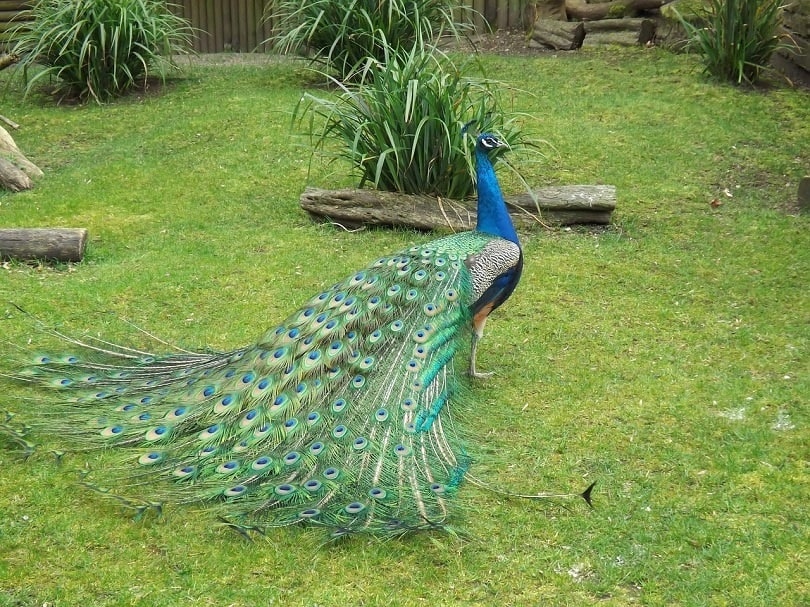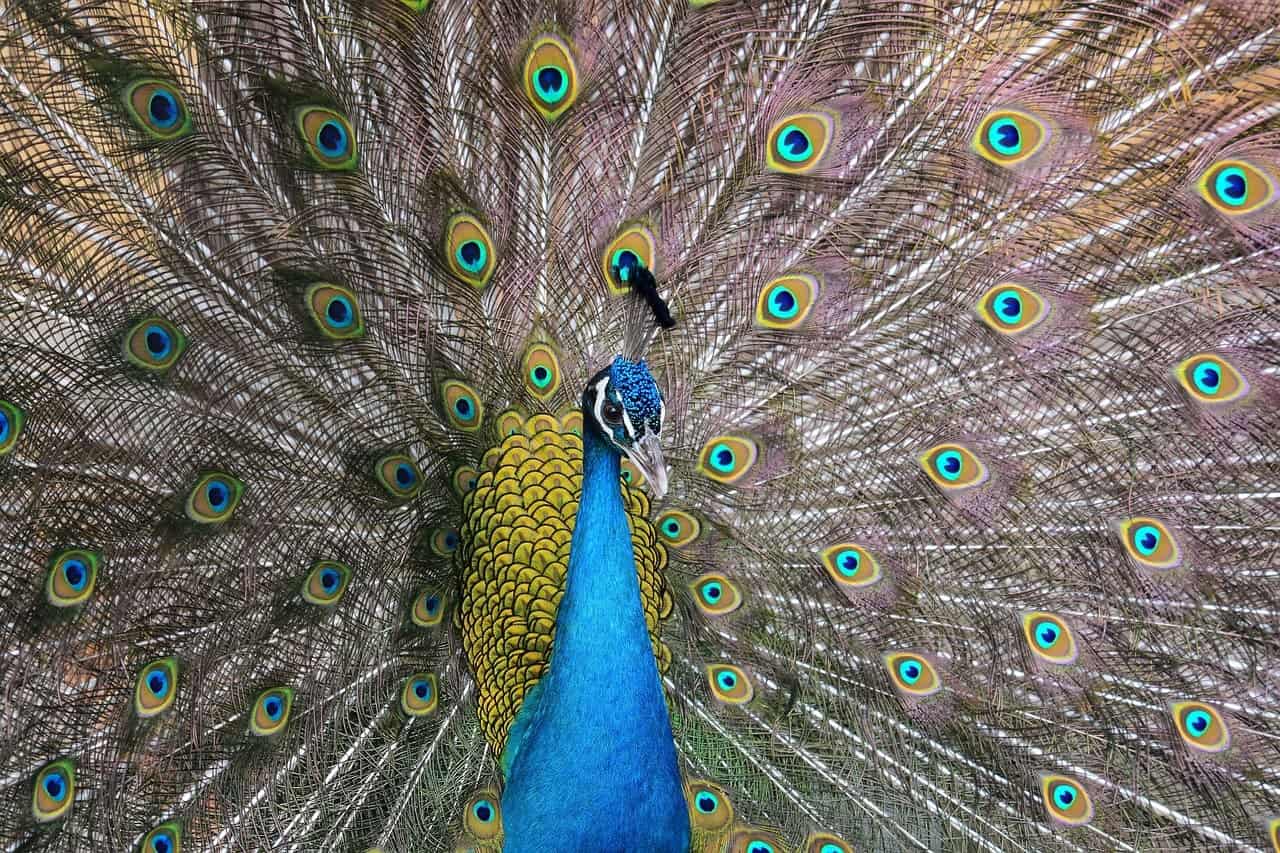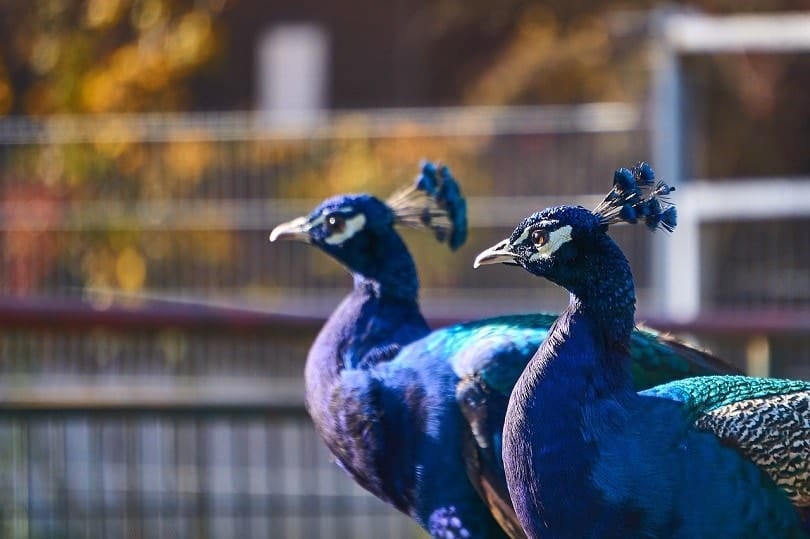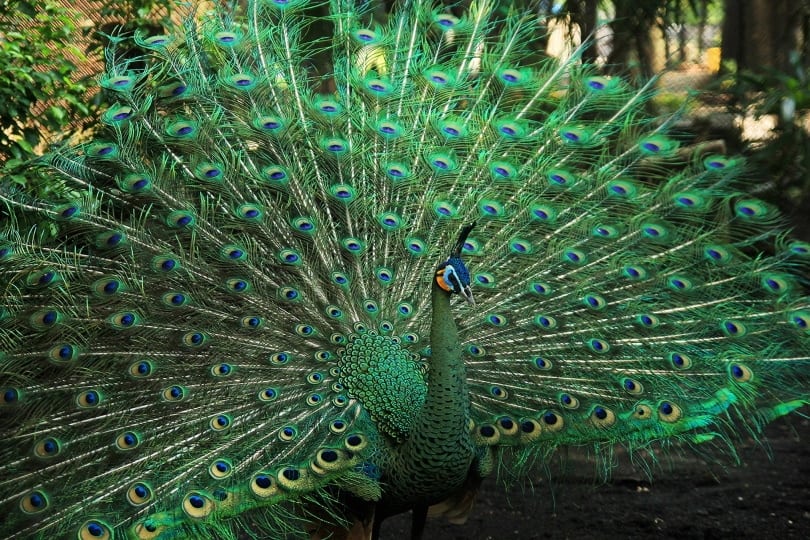Featuring a huge tail, brilliant feathers, and fascinating patterns on their body, peacocks are one of the most attractive and peculiar creatures known to both young and old.
There is much more to peafowls than their absorbing tail plumage. Learn some peacock facts to understand the importance of their existence to culture and society and why you need to give them the care they deserve.

Top 14 Fascinating Peacock Facts:
1. Peacocks take three years to develop their tail plumage.
When they are born and for months afterward, male and female peachicks appear identical. A male doesn’t develop color until it is about three months old, and it is not until full maturity at 3 years old that its brilliant display tails are in full plumage.

2. Their fascinate plumage is designed to allure peahens.
When a male peacock rattles his peculiar tail, it is not just fascinating and enjoyable to human eyes. Peahens gauge the males’ fitness in their vicinity through this visual display, during which subtle clattering creates a spots’ illusion hanging over a shimmering background.
Some scientists believe that females find the male feathers appealing since they appear like blueberries, while others theorize that the colorful look can help protect them from predators.
In addition, there is evidence that vibrations, dancing (feather moving and shaking), and sounds (peacocks make a peculiar trumpet-like sound) are vital in mate choice among peahens.
3. Peacocks have a long and respected history in many people’s cultures.
Besides being the national bird of India, peacocks have been part of Greek mythology. They were a symbol of immortality, and the people of Ashkenazi Jewish have included golden peacocks as a symbol of creativity.
Early Christian mosaics and paintings usually portray peacocks as the “eyes” where their tail plumage represented the Church or the all-seeing God. In primitive Persia, peacocks were allied with the Tree of Life.

4. Peacocks were a delicacy in Medieval times.
In Medieval times, exotic animals were served at the wealthy tables as a sign of riches. They did not eat the same food as peasants did.
A recipe from that time describes how to prepare peacocks for a feast, which was tricky. The skin was removed with plumage intact so that the bird could be cooked and flavored, and then the skin could be reattached for a fascinating visual display.
According to the English and Australian Cookery Book, no ordinary food can complement a peacock on the table. In the times of chivalry, this ceremony was reserved for the most beautiful lady. She carried it amid inspiring music and placed it at the beginning of the banquet before the lord of the house.
However, peacocks don’t taste like chicken. Records show that many people found them tough and not so flavorful.
5. All-white peacocks are not albinos.
Snow-white peacocks have become more common than they used to be since selective breeding can achieve the characteristic. Unlike albinism, which often involves loss of pigmentation from eyes and feathers, leucism is the genetic condition that leads only to the loss of pigment from plumage, in the case of peacocks.

6. Their dramatic tails are the species default.
Some old peahens might develop peacock feathers and make male sounds.
According to a study on peafowl sex inversion, as peahens become old, those with aged and damaged ovaries stop producing as much estrogen. They begin to sound and look like males since that is the default growth for the animal. Peahens become plainer due to hormones quashing the feathers.
7. The Indian peacock is known as the country’s national bird.
In 1963, the Indian or blue peacock was declared the Indian national bird. According to the IUCN, its range covers almost the whole Indian subcontinent and is regarded as a Least Concern species. It is a wealthy tradition of paintings in Indian and Hindu religious culture, including being allied with gods, goddesses, and royalty.

8. You don’t have to kill a peacock for its feathers.
Luckily, a peacock sheds its train every year after mating season, so you can collect and sell the plumage without causing harm to the bird. The average life expectancy of a peacock in the wild is around 20 years.
9. A peacock’s crest acts as a sensor for mating.
A female peacock features unique sensors in its crest that allow it to detect the vibrations of a mate who is located far away. According to The Atlantic, the plumage is tuned to vibrate at the same frequency at which the exhibiting peacock shakes his tail.
When a male peacock fans out its tail, the female rattles it at a rate of 26 times a second, creating a shock wave that shakes the female’s head for attention.

10. Peacocks’ plumage is covered in microscopic crystal-like structures.
Peacock’s plumage is made so attractive by tiny crystal-like structures that reflect different light wavelengths depending on how the bird spaces them, resulting in bright fluorescent colors. Shimmering butterflies and hummingbirds have the same visual effect on their wings.
11. Peacocks can fake it.
According to recent research, peacocks are not just attractive, but they are intelligent as well.
When peacocks mate with peahens, they produce a loud copulatory sound. Surprisingly, the study discovered that the birds could fake this sound to allure more females. The male bird pretends to be mating when not to convince the female that they are more sexually active and genetically fitter than their competitors.

12. A peacock can fly, despite its massive trains.
Despite their long and heavy tail plumage, which is folded up out of fan position, peacocks often fly short distances to escape a tree branch for protection from predators or to nest at night. A peacock’s tail plumage can grow up to 5 feet long and make up around 60% of its body length.
13. The display of a Congo peafowl tail is more subtle.
The Congo is the lesser-known peafowl species. Native to the Democratic Republic of Congo, the IUCN considers the bird vulnerable with a declining population. Its attractive feathers are deep blue with green and violet shades for males and green and brown with black bellies for females.
Unlike other species of peacocks, a Congo peacock is smaller and has short tail plumage, which it fans out during the mating process.
14. Only males have those long, brilliant plumage.
Like most bird species, only the male peafowls feature such attractive colors and lovely decorative tail plumage. In addition, only the males are called peacocks since the females are called peahens, although both sexes are normally referred to as peacocks. A group of peacocks is known as a bevy, a muster, an ostentation, or even a party.
See Also:
- Peacocks as Pets: 5 Important Things You Need to Know
- What Do Peacocks Eat in the Wild and as Pets? Diet & Health Advice
Featured Image Credit: endri yana yana, Pixabay
